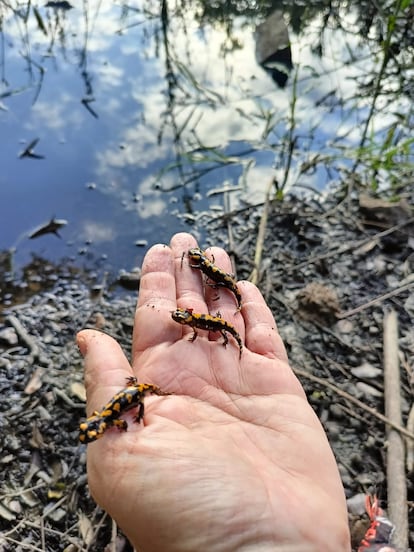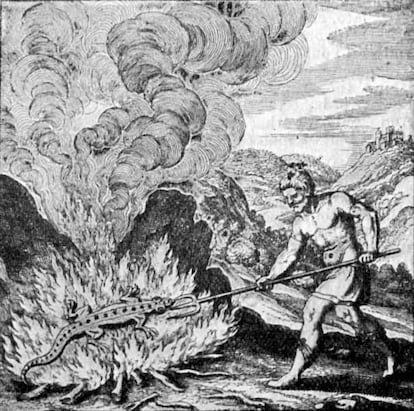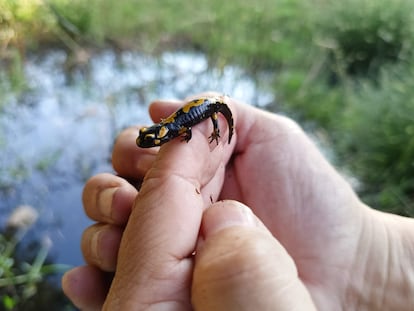Since I had to release the salamanders, like Liberad a Willy but on another scale, I thought what better occasion than for San Juan, on the summer solstice, given the legendary relationship of these amphibians with fire. Many extravagant things are attributed to salamanders (such as the fact that preserved in honey and mixed with food they constitute a powerful aphrodisiac), but the most notable, as is known, is their ability not to burn and even to extinguish fire. It is also funny that the most famous to hold it, Pliny the Elder (Natural HistoryBook X, chapter 67), died in the eruption of Vesuvius that buried Pompeii… Pliny claimed that the salamander is so intensely cold that it extinguishes flames as ice does, so it is likely that the wise man had never touched a salamander in his entire Roman life.
Anyway, I said I had to release my salamanders, which deserves an explanation. I had collected them from a pond in Viladrau in their larval state, which is aquatic, and they have resided at home until they metamorphosed and became miniature copies of the adult salamander that everyone knows, black and yellow (aposematism, it is called : striking features of poisonous animals to ward off predators). The pact—with myself—is that I take them out of the pond, which usually dries up, which condemns the larvae, and I return them to the same place after offering them a temporary foster home. I have been doing this, which today is seen almost as a crime (and almost certainly, because salamanders are a protected species), for many years (when I started I was about the age of Gerald Durrell in Corfu, and I also put water snakes in the bathtub), and I have become, without intending it, a specialist in these amphibians: I am even capable of sexing them, if I let them.
And I’m not the one saying that I know a lot about them: it’s something that the salamanders themselves can attest to, for which I have a very high survival rate that has reached 100% in this last breeding episode. Indeed, the seven larvae that I extracted from the pond, with such rustic means as a can of tennis balls, a plastic container of Krit biscuits from Cuétara (krititas) and a kitchen strainer, have all survived to be reintroduced. Their care has required practically disabling one of the sinks in the house, converted into a nursery of salamanders with two terrariums, one aquatic and semi (with a flat stone so that they can climb on when carrying out the metamorphosis, since in water they would drown) and another completely terrestrial, with earth and moss, to which they are transferred when the change is complete already. Add containers for the small prey on which my beloved urodeles live, supplies of mineral water, decorative vegetables, and various gadgets to supply food to the specimens, in addition to a conspicuous reference library presided over by the indispensable The genus Salamandrafrom Seidel and Gerhardt (Chimaira, 2016).

My salamanders, although I don’t know if they are mine or I am theirs, given the servitude to which they force me, belong to the Franco-Catalan subspecies. Salamandra salamandra terrestriswhich is the one in Montseny and is different from others on the peninsula such as ss almanzoris, fastuosa o morenica, Although there is quite a bit of confusion with all this about species. The name I love is the one given to the generic common salamander (Salamandra salamandra) in English: fire salamanderfire salamander, which seems to come from old salamandrology and even alchemy. Which brings us back to St. John.
The summer solstice festival has always been my favorite since I was a teenager, for the romanticism of the festivals and for the precocious reading, a product of the youthful sentimental failures of the aforementioned festivals, which left me a lot of free time, The Golden Boughby Frazer, one of my favourite books despite its obsolescence (1922, the abbreviated version of almost 900 pages). On Saint John’s Day, June 24 and its eve, the official birth of Saint John the Baptist is celebrated (it would have been a great Day of the Dance), who baptised Jesus Christ and literally lost his head for Salome, it is not clear if it was a day of verbena. But in reality, says Frazer, what the festival did was to superimpose a Christian veneer on the whole series of pagan solstice celebrations in Europe, which were celebrated with bonfires. The idea of fire and fire festivals, of course, is to restore strength to the sun at that critical moment when it reaches its peak and begins its decline, to rekindle the flame so to speak. In Provence a boy was chosen as king to preside over the festival. The lad was selected for his ability to hunt woodpeckers, probably because of the association of these, whose males have red necks, with the sun (and the staccato from his pecking at the firecrackers, I add). More interesting is that some bonfires were lit to scare away dragons, creatures related to fire such as salamanders, and it was believed that they were more active around San Juan. Frazer mentions a tradition according to which “pernicious dragons”, excited by the summer heat, “copulated in the air and poisoned the wells and rivers when their semen fell into them”: you have to see how entertaining it is. The Golden BoughOn Saint John’s Day, witches and the brotherhood of the green wolf also came out, luckily this one only in Jumièges, Normandy.

So last San Juan, June 24, my daughter Rita, her partner Ramón, their one-month-old baby, Mateo, the salamanders and I went on an afternoon excursion to the Can Batllic pond, where Rita, then pregnant, and I had picked them up on March 30. Mateo, huddled in a backpack, didn’t seem to notice much, but surely more than on his previous visit to the pond. I liked the idea of him coming because it was like closing the circle: the larvae had metamorphosed and he had been born. Everything followed its natural course, which would now culminate with the release of the salamanders on a day so propitious to the creatures of fire. On the way we saw two hares, greeted with joy by my companions, so I refrained from commenting that Frazer says that it was believed that witches transformed into these animals (even more than into cats) and that for this reason they were usually burned in the solstice bonfires. Once we reached the pond, next to the old farmhouse from 1724 that holds so many memories, I proceeded to circle it twice (some ceremony must be invented) and took the little salamanders out of their mini-travel terrarium, leaving them among the vegetation around the water. I cannot say whether they recognized their birthplace as larvae (mother salamanders give birth to their young alive by depositing them in the water), but they soon disappeared into the ground, dissolving their small splendor in the grass.

A great sadness overwhelmed me, after all we had been living together for three months, some festival loves lasted less. What would become of them? Of the salamanders I say. Beyond that melancholy, the act had no dramatic component, no matter how much Frazer put into it. Then I saw that my daughter had reserved her last salamander to release herself and was placing it in the palm of her hand before the dark, wide eyes of her son. Amphibian and baby seemed to look at each other as if they shared something that the rest of us missed. The sun, already very low, then emerged from the clouds and a reddish glow seemed to set the two creatures on fire. It was a magical moment. I don’t know what it will mean in Mateo’s life, but not all children have a salamander as their godmother, nor does fate give them a baptism of fire for Saint John.

